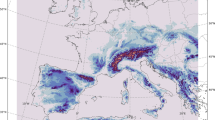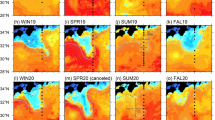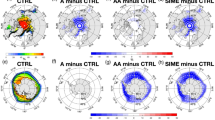Abstract
In order to investigate air-sea interactions during the life cycle of typhoons and the quantificational effects of typhoon-induced SST cooling on typhoon intensity, a mesoscale coupled air-sea model is developed based on the non-hydrostatic mesoscale model MM5 and the regional ocean model POM, which is used to simulate the life cycle of Typhoon Chanchu (2006) from a tropical depression to a typhoon followed by a steady weakening. The results show that improved intensity prediction is achieved after considering typhoon-induced SST cooling; the trend of the typhoon intensity change simulated by the coupled model is consistent with observations. The weakening stage of Typhoon Chanchu from 1200 UTC 15 May to 1800 UTC 16 May can be well reproduced, and it is the typhoon-induced SST cooling that makes Chanchu weaken during this period. Analysis reveals that the typhoon-induced SST cooling reduces the sensible and latent heat fluxes from the ocean to the typhoon’s vortex, especially in the inner-core region. In this study, the average total heat flux in the inner-core region of the typhoon decrease by 57.2%, whereas typhoon intensity weakens by 46%. It is shown that incorporation of the typhoon-induced cooling, with an average value of 2.17°C, causes a 46-hPa weakening of the typhoon, which is about 20 hPa per 1°C change in SST.
Similar content being viewed by others
References
Bao, S., L. Xie, and S. Raman, 2004: A numerical study of a TOGA-COARE squall-line using a coupled mesoscale atmosphere-ocean model. Adv. Atmos. Sci., 21(5), 708–716.
Bender, M. A., and I. Ginis, 2000: Real-case simulations of hurricane-ocean interaction using a high-resolution coupled model: effects on hurricane intensity. Mon. Wea. Rev., 128, 917–945.
Cayan, D. R., 1992: Latent and sensible heat flux anomalies over the northern oceans: Driving the sea surface temperature. J. Phys. Oceanogr., 22, 859–881.
Chan, J. C. L., Y. Duan, and L. K. Shay, 2001: Tropical cyclone intensity change from a simple ocean-atmosphere coupled model. J. Atmos. Sci., 58, 154–172.
Chang, S. W., and R. A. Anthes, 1978: Numerical simulation of ocean’s nonlinear baroclinic response to translating hurricanes. J. Phys. Oceanogr., 8, 468–480.
Cione, J. J., and E. W. Uhlhorn, 2003: Sea surface temperature variability in hurricanes: implications with respect to intensity change. Mon. Wea. Rev., 131, 1783–1795.
Davis, C. A., and L. F. Bosart, 2001: Numerical simulations of the genesis of hurricane Diana (1984). Part I: Control Simulation. Mon. Wea. Rev., 129, 1859–1881.
Elsberry, R. L., T. Fraim, and R. Trapnell, 1976: A mixed layer model of the ocean thermal response to hurricane. J. Geophys. Res., 81(C6), 1153–1162.
Emanuel, K. A., 1986: An air-sea interaction theory for tropical cyclones, Part I: Steady-state maintenance. J. Atmos. Sci., 43, 585–604.
Emanuel, K. A., 1991: The theory of hurricanes. Annual Review of Fluid Mechanics, 23, 179–196.
Falkovich, A. I., A. P. Khain, and I. Ginis, 1995: Motion and evolution of binary tropical cyclones in a coupled atmosphere-ocean numerical model. Mon. Wea. Rev., 123, 1345–1363.
Holland, G. J., 1997: The maximum potential intensity of tropical cyclones. J. Atmos. Sci., 54, 2519–2541.
Huang, L. W., G. X. Wu, and R. C. Yu, 2005: The effects of mesoscale air-sea interaction on heavy rain in two typhoon processes. Acta Meteorologica Sinica, 63(4), 455–467. (in Chinese)
Khain, A. P., and I. D. Ginis, 1991: The mutual response of a moving tropical cyclone and the ocean. Beitr. Phys. Atmos., 64, 125–142.
Price, J. F., 1981: Upper ocean response to a typhoon. J. Phys. Oceanogr., 11, 153–175.
Price, J. F., T. B. Sanford, and G. Z. Forristall, 1994: Forced stage response to a moving hurricane. J. Phys. Oceanogr., 24, 233–260.
Ren, X., and W. Perrie, 2006: Air-sea interaction of typhoon Sinlaku (2002) simulated by the Canadian MC2 model. Adv. Atmos. Sci., 23(4), 521–530, doi: 10.1007/s00376-006-0521-4.
Sakaida, F., H. Kawamura, and Y. Toba, 1998: Sea surface cooling caused by typhoons in the Tohuku area in August 1989. J. Geophys. Res., 103(C1), 1053–1065.
Schade, L. R., and K. A. Emanuel, 1999: The ocean’s effect on the intensity of tropical cyclones: results from a simple coupled atmosphere-ocean model. J. Atmos. Sci., 56, 642–651.
Shay, L. K., P. G. Black, A. J. Mariano, J. D. Hawkins, and R. L. Elsberry, 1992: Upper ocean response to hurricane Gilbert. J. Geophys. Res., 97(C12), 20227–20248.
Shay, L. K., J. G. Gustavo, and P. G. Black, 2000: Effects of a warm oceanic feature on Hurricane Opal. Mon. Wea. Rev., 128, 1366–1383.
Sheng, J., X.-M. Zhai, and R. J. Greatbatch, 2006: Numerical study of the storm-induced circulation on the Scotian Shelf during Hurricane Juan using a nested-grid ocean model. Progress in Oceanography, 70, 233–254.
Sutyrin, G. G., and A. P. Khain, 1979: Interaction of ocean and the atmosphere in the area of moving tropical cyclone. Dokl. Akad. Aauk USSR, 249, 467–470.
Sutyrin, G. G., and A. P. Khain, 1984: On the effect of air-ocean interaction on the intensity of a moving tropical cyclone. Atmospheric and Oceanic Physics, 20, 787–794.
Wada, A., 2005: Numerical simulations of sea surface cooling by a mixed layer model during the passage of typhoon Rex. J. Phys. Oceanogr., 61, 41–57.
Warner, T. T., M. N. Lakhtakia, J. D. Doyle, and R. A. Pearson, 1990: Marine atmospheric boundary layer circulations forced by Gulf Stream sea surface temperature gradients. Mon. Wea. Rev., 118, 309–323.
Weatherford, C. L., and W. M. Gray, 1988: Typhoon structure as revealed by aircraft reconnaissance. Part I: Data analysis and climatology. Mon. Wea. Rev., 116, 1032–1043.
Zhang, Y. C., and Y. F. Qian, 1999: Numerical simulation of the regional ocean circulation in the coastal area of China. Adv. Atmos. Sci., 16(3), 443–450.
Zhu, H., W. Ulrich, and R. K. Smith, 2004: Ocean effects on tropical cyclone intensification and inner-core asymmetries. J. Atmos. Sci., 61, 1245–1258.
Zhu, T., and D.-L. Zhang, 2006: The impact of the storm-induced SST cooling on hurricane intensity. Adv. Atmos. Sci., 23(1), 14–22.
Author information
Authors and Affiliations
Corresponding author
Rights and permissions
About this article
Cite this article
Jiang, X., Zhong, Z. & Liu, C. The effect of typhoon-induced SST cooling on typhoon intensity: The case of Typhoon Chanchu (2006). Adv. Atmos. Sci. 25, 1062–1072 (2008). https://doi.org/10.1007/s00376-008-1062-9
Received:
Revised:
Published:
Issue Date:
DOI: https://doi.org/10.1007/s00376-008-1062-9




